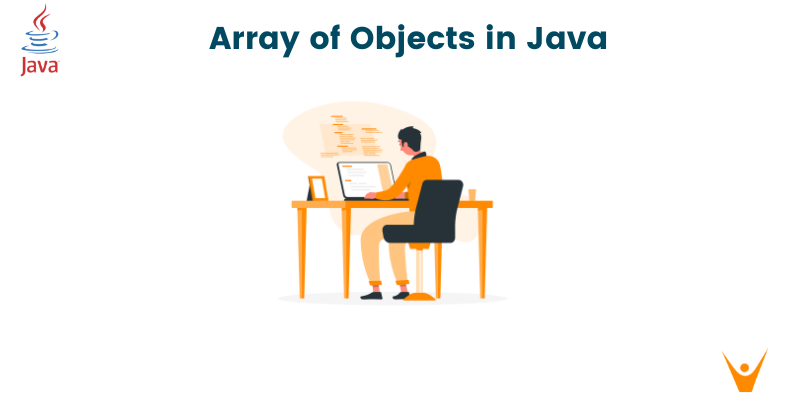Arrays in Java provide a way to store multiple elements of the same data type under a single variable name. When it comes to arrays of objects, Java allows us to create arrays where each element is an object of a particular class. This concept enables the storage and manipulation of multiple instances of a class within a structured collection. Arrays of objects in Java help organize lots of similar things together. This article will show you how to make and use arrays step by step. You'll learn how to put objects inside arrays, change them, and do things with them.
What is an Array of Objects?
Arrays of objects in Java are collections that can store multiple instances of a class. They follow a similar structure to arrays of primitive data types but instead hold references to objects. Defining an array of objects involves declaring the array variable and then allocating memory for the objects. Let’s explore both of them.
Declaring Arrays of Objects
To declare an array of objects, the syntax involves specifying the class type followed by square brackets []:
MyClass[] objectArray = new MyClass[5];
This line of code declares an array objectArray capable of holding 5 instances of the MyClass objects. However, at this point, the array only contains null references and doesn't hold any actual objects. It's essential to initialize each element ef the array to store objects.
Initialization and Memory Allocation of Array of Objects
Initializing an array of objects involves creating individual objects and assigning them to each element of the array:
objectArray[0] = new MyClass(); objectArray[1] = new MyClass(); // ... (initializing other elements)
Here, each index in the objectArray is assigned a new instance of the MyClass object using the new keyword. It's important to note that memory is allocated for the objects themselves, not the array, and each element holds a reference to an object.
Accessing Elements in Arrays of Objects
Accessing elements in arrays of objects is similar to accessing elements in regular arrays. Each element can be accessed by its index.
MyClass obj = objectArray[0]; // Use obj to perform operations or access properties/methods of MyClass
Here, objectArray[0] retrieves the object reference stored at index 0, allowing operations or access to the properties and methods of the MyClass object.
Iterating Through Array Elements
Iterating through an array of objects is commonly done using loops, like the enhanced for loop or traditional for loop, to access each element:
for (MyClass obj : objectArray) { // Perform operations on each obj (MyClass object) }
Or using a traditional for loop:
for (int i = 0; i < objectArray.length; i++) { MyClass obj = objectArray[i]; // Perform operations on obj }
These iterations allow developers to access, manipulate, or perform operations on each object stored within the array.
An array of Objects is one of the trickiest questions students get baffled within their homework. But no worries, get the best Java Assignment Help online in town.
Use Cases of Arrays of Objects
Let’s discuss the use cases of arrays of objects.
1. Manipulating Array Elements
Arrays of objects allow for manipulation of individual elements, enabling updates to object properties or addition/removal of objects.
2. Updating Object Properties
Manipulating properties of objects within the array involves direct access to each object and updating its attributes:
objectArray[0].setName("NewName");
This line updates the name attribute of the first MyClass object in the array using the method.
3. Adding and Removing Objects
Java arrays have a fixed size once created. However, arrays are objects themselves, and to add or remove elements dynamically, various approaches are employed, such as using collections like ArrayList or creating a new array with a different size and copying elements.
MyClass[] newArray = Arrays.copyOf(objectArray, objectArray.length + 1); newArray[objectArray.length] = new MyClass();
This code snippet creates a new array (newArray) by copying the elements from the existing objectArray end then appends a new MyClass object at the end ef the new array.
4. Sorting and Searching in Arrays of Objects
Sorting and searching in arrays of objects involve leveraging Java's built-in sorting mechanisms and implementing comparison logic for objects.
5. Implementing Comparable or Comparator
For sorting objects in arrays, the objects should implement the Comparable interface or utilize a separate Comparator class to define comparison rules:
public class MyClass implements Comparable<MyClass> { @Override public int compareTo(MyClass other) { // Comparison logic here } }
Alternatively, using a Comparator for custom sorting criteria:
public class MyComparator implements Comparator<MyClass> { @Override public int compare(MyClass obj1, MyClass obj2) { // Comparison logic here } }
6. Searching for Objects in Arrays
Searching for objects in arrays typically involves iterating through the array and comparing objects based on specific criteria:
for (MyClass obj : objectArray) { if (obj.getName().equals("TargetName")) { // Object found, perform actions break; // Break out of loop after finding the object } }
This loop traverses through the array, checking if any MyClass object has a name equal to "TargetName," allowing actions to be taken once the object is found.
Multidimensional Arrays of Objects
Multidimensional arrays in Java can store arrays as elements. For arrays of objects, this means creating arrays where each element is an array of objects.
Defining and Initializing Multidimensional Arrays
We can define the multidimensional arrays using:
// Declaration and initialization of a 2D array of MyClass objects
MyClass[][] objectArray2D = new MyClass[3][4];
This line declares a 2D array objectArray2D capable of holding 3 arrays, each containing 4 MyClass objects. Similar to regular arrays, this initialization only allocates memory; the array elements are initially null.
Initializing elements in a multidimensional array involves nesting loops to access and initialize each element:
for (int i = 0; i < objectArray2D.length; i++) { for (int j = 0; j < objectArray2D[i].length; j++) { objectArray2D[i][j] = new MyClass(); // Initializing each element with a new object } }
This nested loop initializes each element ef the 2D array with a new instance of the MyClass object.
Accessing and Manipulating Elements in Multidimensional Arrays
Accessing elements in multidimensional arrays involves using nested loops to traverse through the array's rows and columns:
for (int i = 0; i < objectArray2D.length; i++) { for (int j = 0; j < objectArray2D[i].length; j++) { MyClass obj = objectArray2D[i][j]; // Accessing each object in the 2D array // Perform operations on obj (MyClass object) } }
This loop accesses each MyClass object stored in the 2D array object Array 2D, allowing operations to be performed on each object.
Manipulating elements in multidimensional arrays follows similar principles to that of regular arrays. For instance, updating object properties or performing addition/removal operations can be achieved by accessing and modifying individual elements within the array.
Use Cases and Examples of Multidimensional Arrays of Objects
Multidimensional arrays of objects find applications in scenarios where data needs to be organized in a matrix-like structure, such as representing a grid of objects, tabular data, or a matrix of elements.
For instance, in a game development context, a 2D array of GameObject instances might represent a grid of game elements, where each element contains properties like position, type, and status.
Conclusion
Arrays of objects in Java serve as powerful tools for organizing and managing collections of related objects within a structured format. Through this article, we have explored the fundamental aspects and practical applications of arrays of objects, delving into their creation, manipulation, best practices, and considerations.
From the basics of defining arrays of objects to working with multidimensional arrays, we've covered how these constructs facilitate the storage and manipulation of multiple instances of a class efficiently. Understanding array initialization, element access, manipulation, and iteration forms the core of utilizing arrays of objects effectively.








